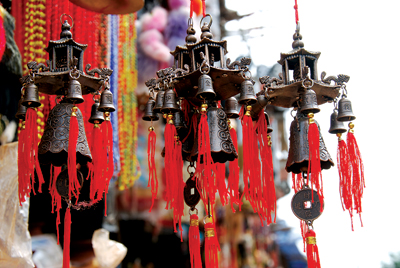The soothing tinkles of wind chimes are ever comforting and calming. When the wind grazes the wind catcher, the flow of musical chimes fills the air with tranquility. And if the elegant frame is pleasing to the eye, the resonating sound it generates is a treat to the ears.

Wind chimes come in all shapes, sizes and styles
Today, wind chimes occupy a fair share of space in interior decorations. We even find bell-like wind chimes in temples and Buddhist monasteries. Hung by the ledge of the door, window or just any place that receives plenty of wind, wind chimes evoke a haunting melody, adding to the serene ambiance.
Wind chimes have different appearances – intricate bell like instruments, a cluster of aluminum tubes around a clapper, or just a bunch of similar looking objects suspended from a ring-like structure with a wind catcher. These graceful musical devices are made of different materials ranging from various metals, including clay and wood. Bamboo wind chimes and wind bells are also quite popular. The present day decorative wind chimes are a result of alteration and transformation over time in various cultures. The genuine original wind chimes date back to prehistoric times, and archaeological evidences point to the fact that East and South Asia are their actual places of origin.

Bell shaped wind chimes lining
the eaves of a temple
Wind chimes were considered religious objects believed to attract kind spirits and drive away evil ones. The Buddhists especially revere wind bells and hung them by the hundreds from the eaves of shrines, pagodas, temples as well as in caves. Wind chimes were also used for immediate weather forecasting, observing conditions such as wind speed and direction. In China and Japan, they started being used as decorative pieces in private homes. Their popularity spread widely among Western countries in the 19th and 20th centuries and, today, wind chimes are used extensively around the world with the belief that they bring good luck.
Going beyond their appearance and decorative attributes, wind chimes have a much deeper significance: they can have a healing effect on both the mind and body. The resonance and vibration of their sounds are considered to release stress, release emotional blockages in the body and calm the mind, thereby enhancing conscious awareness and connection with the spirit. The sounds of wind chimes are thought to be positive that usher relaxation and reduce anger and tension. Wind chimes help instilling in us a sense of peace and wellbeing, too. It is believed that they can help bring balance and harmony to your garden and home, and they are also often used in Feng Shui.
Nepal has also been making its mark in the international wind chime market. Clay wind chimes, wood wind chimes, bamboo wind chimes and Tibetan standing wind chimes are a few of the locally manufactured varieties. These wind instruments, as already mentioned, are very popular in Western countries where most of them are exported to, and among the foreigners who buy them as souvenirs. Be it on an international or national level, for decorative purposes, religiosity or as stimulants for good health and wellbeing, wind chimes will always be popular the world over for their aesthetic simplicity and the enduring sweet notes they leave lingering in the air.











